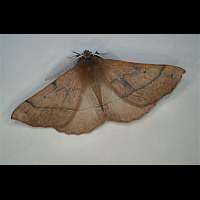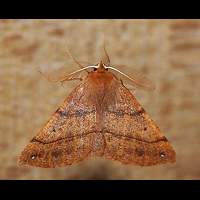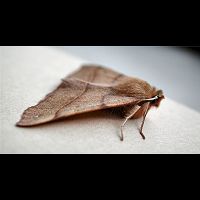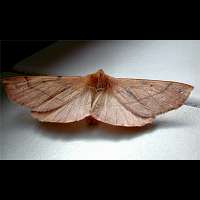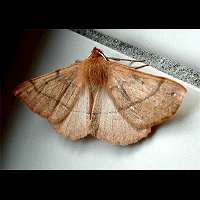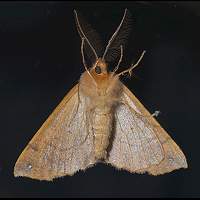Feathered Thorn (Colotois pennaria)
The Feathered Thorn is quite a big, rather stout Geometer. The ground colour of the wings is reddish brown to greyish brown and it has the head covered in thick, reddish hairs. On the wings run two dark lines: one just there where the hairs stop and the second one quite close to the edge of the wing. Between the two lines are some very variable dark dots or smears. Usually males are more marked than the females are. The lower edges of the wings are wavily notched. It has big feathery antennae (both sexes!). Coloured like the other thorns, it rests with the wings in a flat position, unlike most others. There is no species like it flying that late in the year. The Feathered Thorn reaches a wingspan of some 46 to 50 mm.
The eggs are laid in autumn in groups on the twigs of one of the foodplants. They hatch next spring. The larvae have an indistinct greyish brown colour with some darker dots or smears. Near the tail are two light brown conical warts. The head is bright brown. They may grow up to 5 cm and are rather fat, especially considering they are Geometers. During the day they rest motionless on the foodplants and mainly feed by night. In June the caterpillars go underground and pupate. The butterflies usually appear in October. The larvae feed on a great variety of trees and shrubs, including Birch, Oak, Hawthorn, Blackthorn and Sallow.
The Feathered Thorn is on the wing from mid-September to Mid-November, but is usually seen in October mainly. The males are capable flyers and are attracted to light easily. The females do not fly about a lot and are usually just sitting on a tree trunk, awaiting the arrival of a male. During mild nights the male may fly from just after dark to well after midnight. A woodland species, very common in southern Britain, but scarcer northwards and a local species in Scotland. Very common on the continent as well.
The Feathered Thorn is quite a big, rather stout Geometer. The ground colour of the wings is reddish brown to greyish brown and it has the head covered in thick, reddish hairs. On the wings run two dark lines: one just there where the hairs stop and the second one quite close to the edge of the wing. Between the two lines are some very variable dark dots or smears. Usually males are more marked than the females are. The lower edges of the wings are wavily notched. It has big feathery antennae (both sexes!). Coloured like the other thorns, it rests with the wings in a flat position, unlike most others. There is no species like it flying that late in the year. The Feathered Thorn reaches a wingspan of some 46 to 50 mm.
The eggs are laid in autumn in groups on the twigs of one of the foodplants. They hatch next spring. The larvae have an indistinct greyish brown colour with some darker dots or smears. Near the tail are two light brown conical warts. The head is bright brown. They may grow up to 5 cm and are rather fat, especially considering they are Geometers. During the day they rest motionless on the foodplants and mainly feed by night. In June the caterpillars go underground and pupate. The butterflies usually appear in October. The larvae feed on a great variety of trees and shrubs, including Birch, Oak, Hawthorn, Blackthorn and Sallow.
The Feathered Thorn is on the wing from mid-September to Mid-November, but is usually seen in October mainly. The males are capable flyers and are attracted to light easily. The females do not fly about a lot and are usually just sitting on a tree trunk, awaiting the arrival of a male. During mild nights the male may fly from just after dark to well after midnight. A woodland species, very common in southern Britain, but scarcer northwards and a local species in Scotland. Very common on the continent as well.

